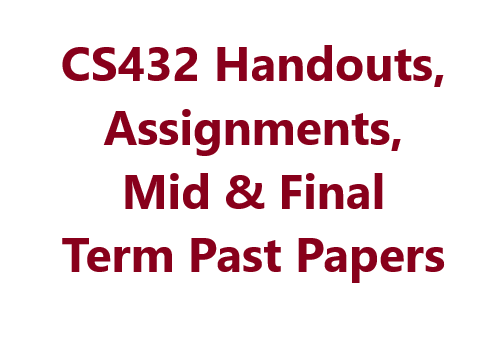CS432 Handouts, Assignments, Mid & Final Term Past Papers are discussed below. This course on network modelling and simulation is at the very beginning level. In this course, you will study the foundations of modeling within the framework of computer networks. For the simulation part, we will use the OMNET++ simulator. Using the information acquired throughout the simulation, you will learn how to use this simulator and do network analysis.
Network modelling and simulation are frequently used interchangeably. It’s not, in fact! Simulation is the computational re-enactment of rules from a model to mimic the behavior of a real-world system. In contrast, modelling comes before simulations. Combined, they make an iterative technique that simulates systems in the actual world. the rational depiction of a complex model item, system, phenomena, or process. In the course of communication, the network model is presented analytically in mathematical form as a closed or approximative state machine.

CS432 Handouts, Assignments, Mid & Final Term Past Papers
Computer simulation is the process of simulating behavior on a computer with software. Accuracy to offer visual understanding. Essentially, it serves as a template for a computer programmed. Take into account a one-hop communication situation with two wireless notebooks linked by a WIFI AP. The simulated entities would be multiple wireless computer instances and their packets, one WiFi AP instance, and one instance of a traffic generator that creates wireless computer instances and their packets. The system states would include WiFi AP states (busy or idle). Each computer generates multiple packets, each of which has a success or failure rate.
The occurrences would involve the development of wireless computers, packet generation, and wireless AP activity. Queues would have to be used to schedule the events. These would include frames (or packets) at the WiFi AP input queue as well as frames (or packets) in the output queue of the wireless computer. Randomization is required to make the simulation engaging, dynamic, and enlightening. Unexpected packet length discoveries, the quantity of wireless computers, the number of frames per wireless computer, the BER (and PER), and the percentage of dropped packets are a few examples of these. packets in the WIFI AP input queue.
Distributing different entities and events is also necessary. The number of frames per wireless computer and the packet length distributions could be gaussian, uniform, etc. The exposed complexity of the system decreases with decreasing number of steps, and vice versa. There is less chance of problems the quicker the management activities are finished. If the switching fabric is n times faster than the input line rates and the maximum queuing delay is (n-1)D.
Assume that each packet has the same length, that n packets arrive at n input ports simultaneously, and that n packets wish to be routed to different output ports. For the (a) memory, (b) bus, and (c) crossbar switching fabrics, what is the maximum packet delay? Subnetting An example would be a subnet with the prefix 128.119.40.128/26. Give an example of a possible IP address for this network.
A subnet’s prefix Let’s say an ISP is the owner of the range of addresses starting with 128.119.40.64/26. Suppose it desires to partition this block into four subnets, each having an identical quantity of IP addresses.
Course Learning Objectives:
This class will be beneficial for
- Study fundamental network modelling and simulation ideas.
- Clarifying the ideas and gaining a thorough understanding of computer networks
-
the capacity to conduct analysis and create models for particular network scenarios
-
The knowledge gained from this course will be helpful in network research.
The virtual router is set up to be each computer’s default gateway. The virtual router’s MAC address is returned by the active HSRP router when a PC broadcasts an ARP frame to determine its default gateway. The HELLO message is also routinely broadcast by the active router. designed to provide a reasonably simple means of supporting a variety of service classes. Queue by default offers FIFO. Must be changed for the priority queuing operation. After classification, packets are placed in different priority queues.
Only when there are no active higher priority queues are packets scheduled from the top of a queue. Packets are arranged in FIFO order within each priority queue. The receiver will not detect the end of the frame and will not perform the cyclic redundancy check (CRC) if a flag at the end of the frame contains an error. The receiver believes the CRC is in the location before the flag when it detects the subsequent flag. The CRC for the following frame may really be this apparent CRC. But the receiver perceives two frames as a single one. The probability that the receiver will miss errors is 2-L, where L is the length of the CRC.
Every frame in DECNET has a fixed-length header. Incorporates frame length in header – Header has its own CRC Limitation: following such a mistake, the transmitter must still resync; the receiver will not know when the next frame begins. Partial Solution 2 – This method avoids the inefficiencies of the DECNET approach but requires a particular synchronizing sequence once each fault is detected. It entails putting one frame’s length field into the previous frame’s trailer.
CS432 Handouts:
The page “CS432 Handouts” that is linked has handouts.
CS432 Past Papers:
CS432 Midterm Past Papers:
Midterm Past Papers for CS432 will shortly be accessible.
CS432 Final Term Past Papers:
The final term past papers for CS432 will shortly be accessible.
CS432 Assignments:
CS432 Assignments will be available soon.